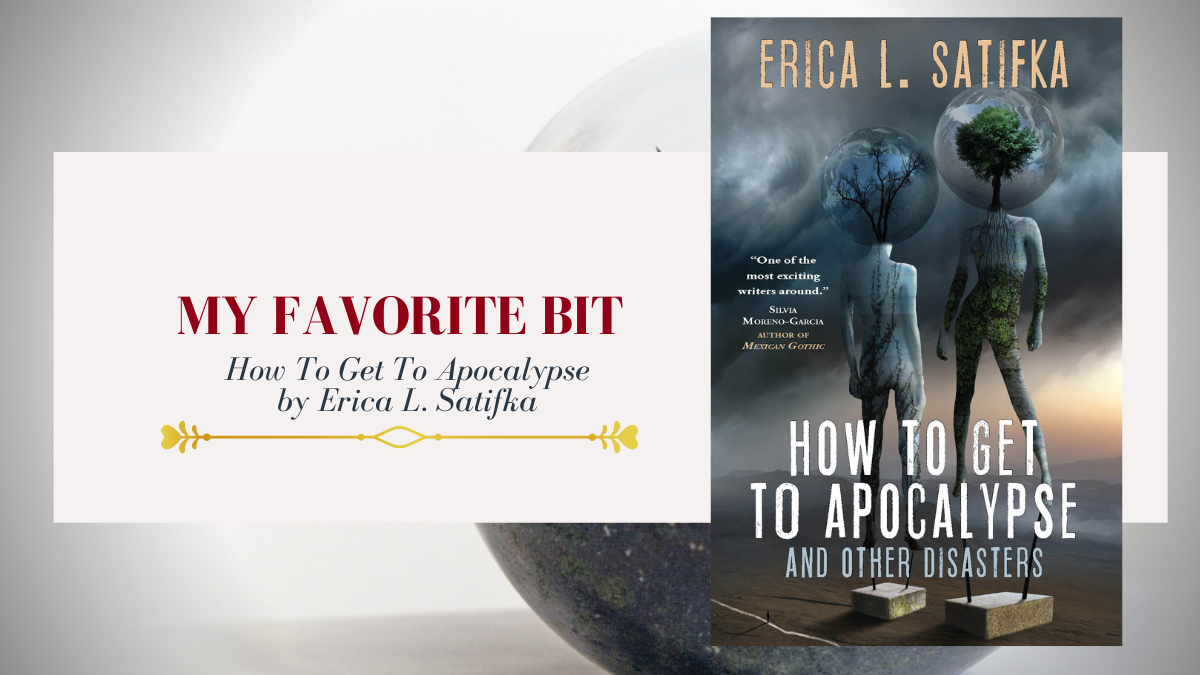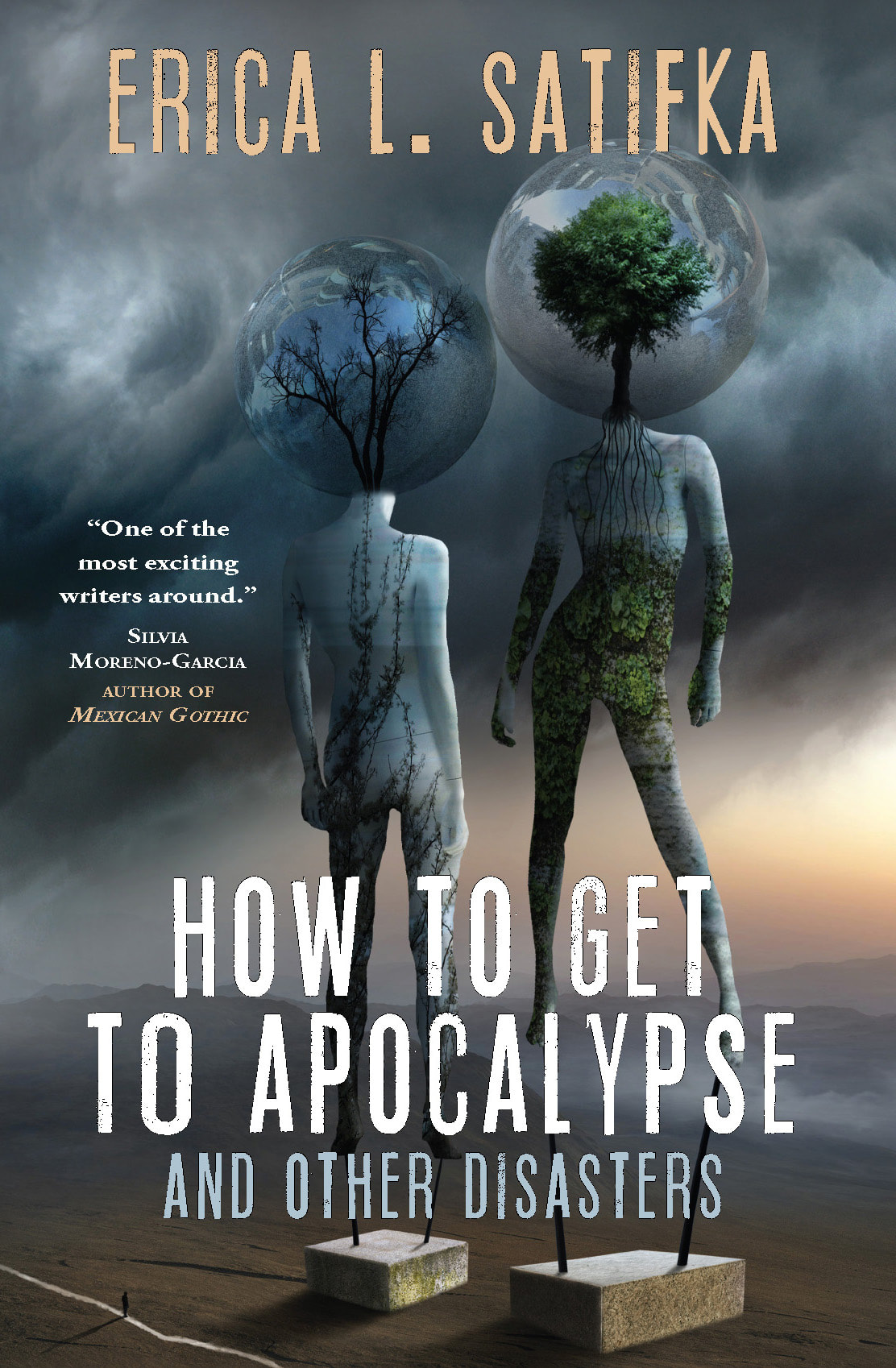
Erika L. Satifka is joining us today to talk about her novel, How To Get To Apocalypse and Other Disasters. Here’s the publisher’s description:
The apocalypse can take many forms. Possibly our end will come by way of an addictive cell phone game that manipulates its users into a crowd-sourced mass murder. Or perhaps our downfall involves aliens drugging us into bliss and then taking it away. Maybe it’ll be technological redundancy that leaves loved ones without a purpose, or corporations replacing the natural world with creatures more amenable to market pressure.
All these apocalypses and many more can be found in Erica L. Satifka’s debut collection, which gathers together twenty-three short stories from the past decade.
What’s Erika’s favorite bit?

ERIKA L. SATIFKA
Choosing a favorite story is kind of like picking your favorite food. You’re always influenced by what you’ve had most recently. When it comes to my stories, I’m proud of all of them—over three dozen of my (almost always) pessimistic tales are out there in the world, hopefully both engaging and depressing readers across the globe. For my collection, How to Get to Apocalypse and Other Disasters, I had to pick the ones I felt best represented my work as an author, which was no easy feat in itself. And selecting just one bit out of these is, well, a lot like herding cats. (I did that in a story once and threw them on a spaceship. You’ll find it in the collection!) But there’s one particular bit I liked a whole lot while I wrote it, and still do. Let me tell you about it…
My collection’s longest story, “The Goddess of the Highway,” is set in a post-apocalyptic world (shocking, I know) where human intelligence has been wiped out by mysterious neurobombs that kick up a brain-killing dust. Cognitive ability is sold back to the people in the form of prosthetic plates wired into their skulls, most of which only allow their wearer to perform the basic functions of their job. It’s a bleak life for most, especially for Harper “Harp” Jones, a long-haul truck driver who occupies the lowest caste, that of the Plastics.
One day in dystopia, Harp finds himself flagged down by a Silver, a member of the third-highest caste, after Golds and the people who run everything behind the scenes, the Platinums. The Silver controls a group of people without plates who make Harp look like a genius. They’re effectively zombie slaves under his complete control. Now he wants Harp to join his macabre collection.
Harp was a fun character to write. His plates filter the nightmare world with an innocent, childlike perspective, which I thought would underscore the horror of the events he faces, such as in this scene of attempted kidnapping and forced mutilation.
The boss man enters, a small satchel in his hand. “My freedom pack,” he says, opening it to reveal tools as silver and shiny as the plates in his head.
“Is it sterile?”
“Such a big word for a Plastic. Must be all those smart pills you have in your truck. You won’t need those anymore.” He flips his hands. “Free as a bird, remember? Not a care in the world.”
Harp looks from the boss man back to the girl and gulps. This is exactly what Greg and Chuck warned him about, to the letter. But this man is a Silver. He’s smarter than Harp is. Could this be the right thing to do? “Maybe it is,” he answers to himself.
“Talking to yourself,” the boss man says. “Oh, those plates have to come out, Harp, they’re malfunctioning on you.”
As the scene progresses, things don’t work out so well for the Silver. He’s thwarted by a man who’s supposed to be dumb as a box of rocks and is eventually run over by that same man’s automated semi. In his innocence, Harp doesn’t quite grasp the boss man’s fate, and he becomes merely “a smear of red” on the highway’s surface as Harp drives away.
What I like about this scene is that it shows Harp’s actual intelligence shining through, even if he’s not able to understand that’s what he’s doing. One of this story’s themes is how our real world’s structure is designed to keep talented people from rising to the surface. Harp’s ability to rise above the expectations of
his exploiters even in his diminished state means a lot. If Harp can do it, so can we.
(By the way, the other narrator in this super-sized story is a Platinum from a powerful political family who is much dumber than her plates make her appear. Her incompetence dovetails nicely with Harp’s rediscovered aptitude.)
There’s a lot more to this story, like the existence of amphetamine-powered “smart houses” that help people think past their plates, a craftily subversive TV channel that shows nothing but colorful shapes, and of course the enigmatic titular goddess who either gives Harp presents or makes him cut off one of his fingers depending on his route – and who might not even exist. I hope that you’ll join me in this post-apocalyptic future, and twenty-two other visions of often-absurdist despair, by picking up a copy of How to Get to Apocalypse and Other Disasters.
LINKS:
How to Get to Apocalypse and Other Disasters Universal Book Link
BIO:
Erica L. Satifka is a writer and/or friendly artificial construct, forged in a heady mix of iced coffee and sarcasm. She enjoys rainy days, questioning reality, ignoring her to-do list, and adding to her collection of tattoos. Her debut novel Stay Crazy is the winner of the 2017 British Fantasy Award for Best Newcomer, and her short fiction has appeared in Clarkesworld, Shimmer, Interzone, and The Dark. Her novella Busted Synapses debuted in 2020 from Broken Eye Books. Originally from Pittsburgh, she now lives in Portland, Oregon with her spouse Rob and an indeterminate number of cats.
